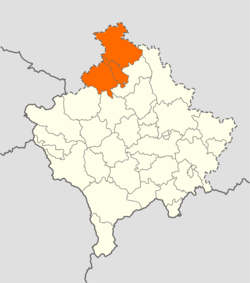Northern Kosovo
|
North Kosovo |
|
|---|---|
| Geographical region | |

North Kosovo is marked in orange
|
|
| Country | Kosovo |
| Largest city | North Mitrovica |
| Government | |
| • Community of Serb Municipalities | TBD |
| Area | |
| • Total | 1,007 km2 (389 sq mi) |
| Population | |
| • Estimate (2015) | 79,910 |
| • Density | 79.3/km2 (205/sq mi) |
| ^ "North Kosovo" is not an official subdivision of the Republic of Kosovo. Ibarski Kolašin is a geographical region. | |
North Kosovo (Serbian: Северно Косово/Severno Kosovo; Albanian: Kosova Veriore), also known as the Ibarski Kolašin (Serbian Cyrillic: Ибарски Колашин; Albanian: Kollashini i Ibrit), is a region in the northern part of Kosovo, composed of four municipalities with ethnic Kosovo Serbs majority: North Mitrovica, Leposavić, Zvečan and Zubin Potok.
Prior to the 2013 Brussels Agreement, the region functioned independently from the institutions in Kosovo, as they refused to acknowledge and recognize the independence of Kosovo, declared in 2008. The Government of Kosovo opposed any kind of parallel government for Serbs in this region. However, the parallel structures were all abolished by the Brussels Agreement, signed between the governments of Kosovo and Serbia. Both governments agreed upon creating a Community of Serb Municipalities. The association was expected to be officially formed in 2016. According to the agreement, its assembly will have no legislative authority and the judicial authorities will be integrated and operate within the Kosovo legal framework.
Following Kosovo's declaration of independence in 2008, Serbs decided to create the Assembly of the Community of Municipalities, elected on 11 May and called by the Government of Serbia. The assembly was composed by 45 representatives. The North Kosovo Serbs had taken a consistently hard line, refusing to cooperate with the government in Pristina or to take up their seats in the Assembly of Kosovo. Their stance was encouraged by the Serbian government of Vojislav Koštunica and they remained in control of this area with their own structures.
...
Wikipedia
